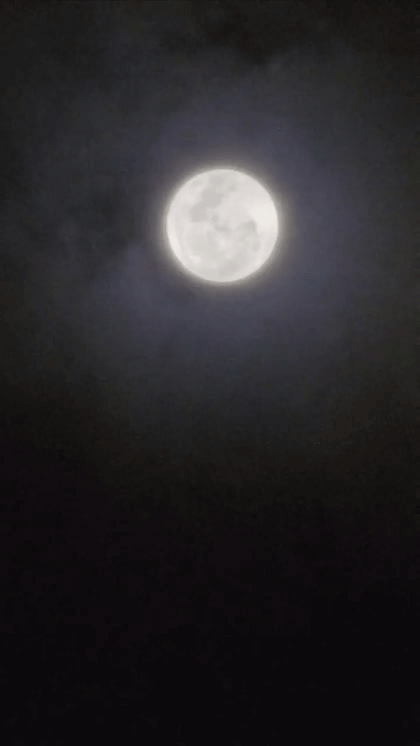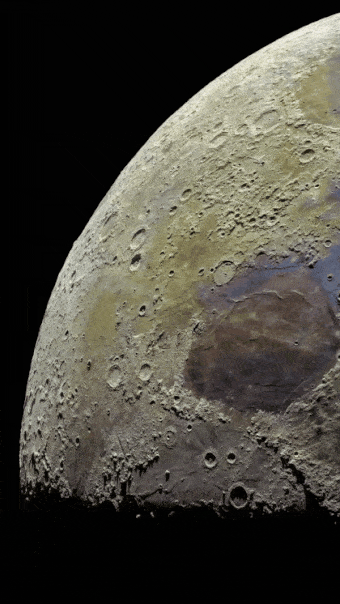-
SCAM WARNING! See how this scam works in Classifieds.
You are using an out of date browser. It may not display this or other websites correctly.
You should upgrade or use an alternative browser.
You should upgrade or use an alternative browser.
I just saw the moon
- Thread starter TheMadDabber
- Start date
CrazyDiamond
HAL is a StarChild
Dark markings and bright nebula in this telescopic southern sky view are telltale signs of young stars and active star formation. They lie a mere 650 light-years away, at the boundary of the local bubble and the Chamaeleon molecular cloud complex. Regions with young stars identified as dusty reflection nebulae from the 1946 Cederblad catalog include the C-shaped Ced 110 just above and right of center, and bluish Ced 111 below it. Also a standout in the frame, the orange tinted V-shape of the Chamaeleon Infrared Nebula (Cha IRN) was carved by material streaming from a newly formed low-mass star. The well-composed image spans 1.5 degrees. That's about 17 light-years at the estimated distance of the nearby Chamaeleon I molecular cloud.
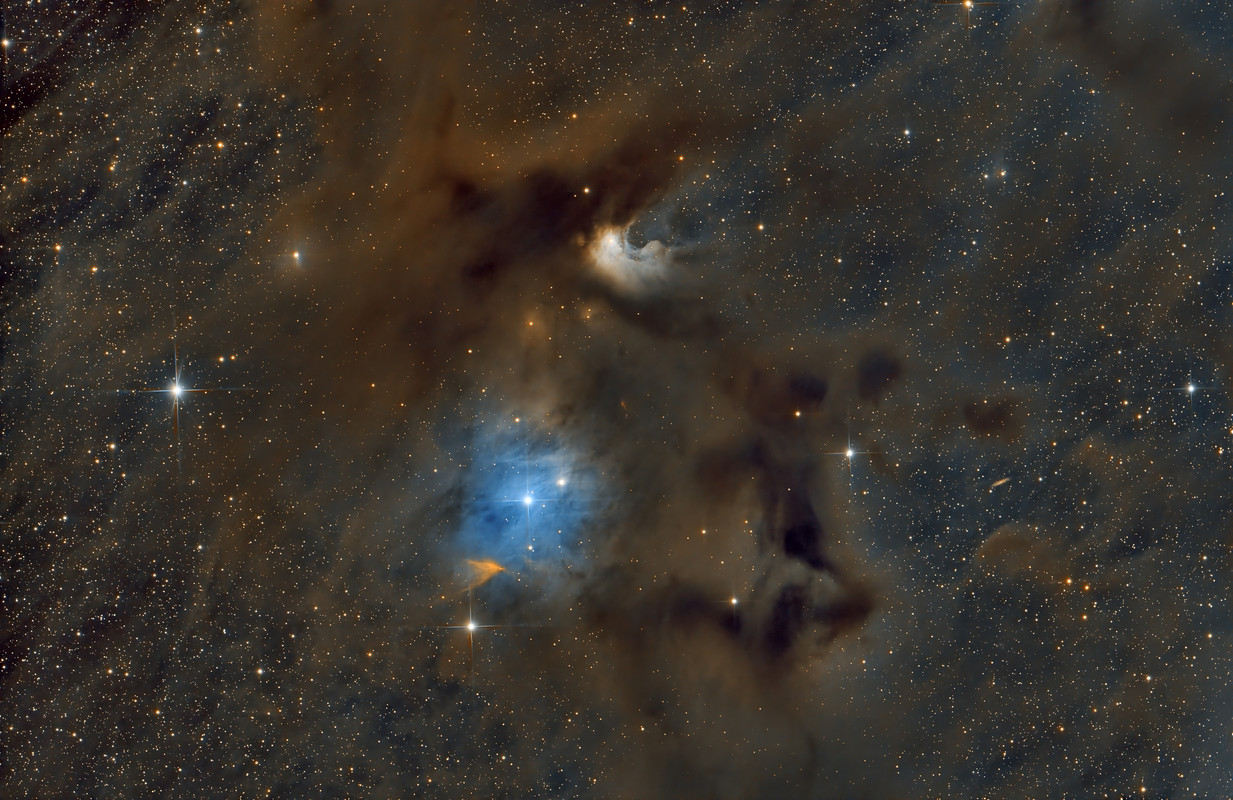
Is the Lion Nebula the real ruler of the constellation Cepheus? This powerful feline appearing nebula is powered by two massive stars, each with a mass over 20 times greater than our Sun. Formed from shells of ionized gas that have expanded, the nebula's energetic matter not only glows, but is dense enough to contract gravitationally and form stars. The angular size of the Lion Nebula, officially named Sh2-132, is slightly greater than that of the full moon. The gaseous iconic region resides about 10,000 light years away in a constellation named after the King of Aethopia in Greek mythology.

Why is the sky near Antares and Rho Ophiuchi so colorful, yet dusty? The colors result from a mixture of objects and processes. Fine dust -- illuminated by starlight -- produces blue reflection nebulae. Gaseous clouds whose atoms are excited by ultraviolet starlight produce reddish emission nebulae. Backlit dust clouds block starlight and so appear dark. Antares, a red supergiant and one of the brighter stars in the night sky, lights up the yellow-red clouds on the upper right of the featured image. The Rho Ophiuchi star system lies at the center of the blue reflection nebula on the left, while a different reflection nebula, IC 4605, lies just below and right of the image center. These star clouds are even more colorful than humans can see, emitting light across the electromagnetic spectrum.
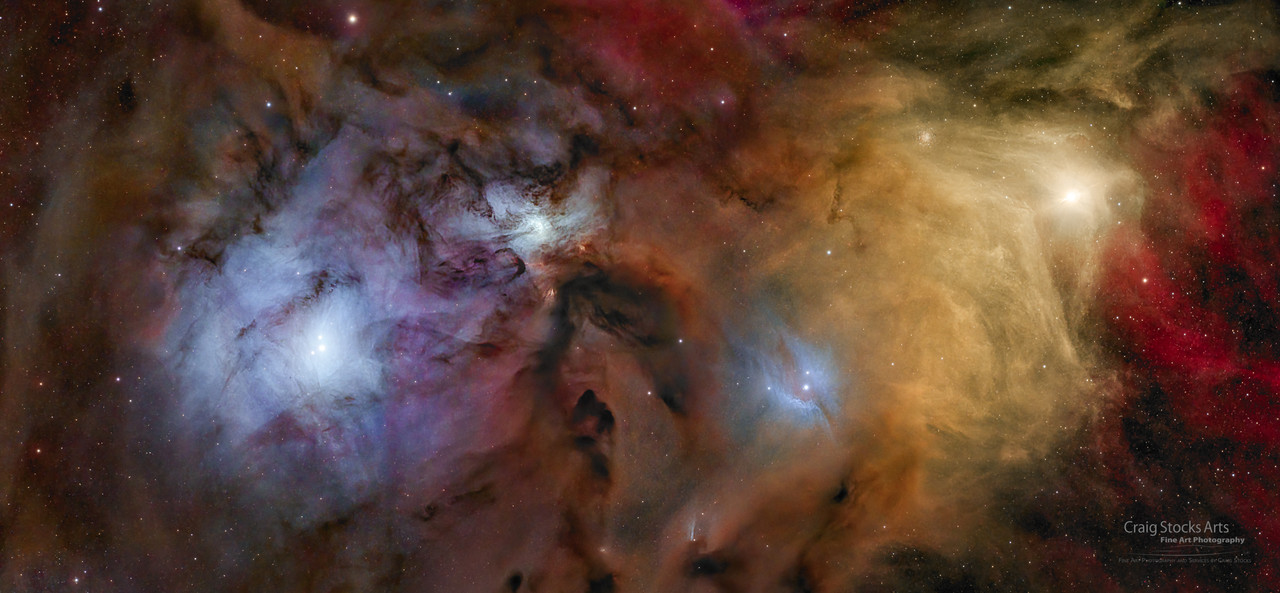
Big, beautiful spiral galaxy Messier 66 lies a mere 35 million light-years away. The gorgeous island universe is about 100 thousand light-years across, similar in size to the Milky Way. This Hubble Space Telescope close-up view spans a region about 30,000 light-years wide around the galactic core. It shows the galaxy's disk dramatically inclined to our line-of-sight. Surrounding its bright core, the likely home of a supermassive black hole, obscuring dust lanes and young, blue star clusters sweep along spiral arms dotted with the tell-tale glow of pinkish star forming regions. Messier 66, also known as NGC 3627, is the brightest of the three galaxies in the gravitationally interacting Leo Triplet.
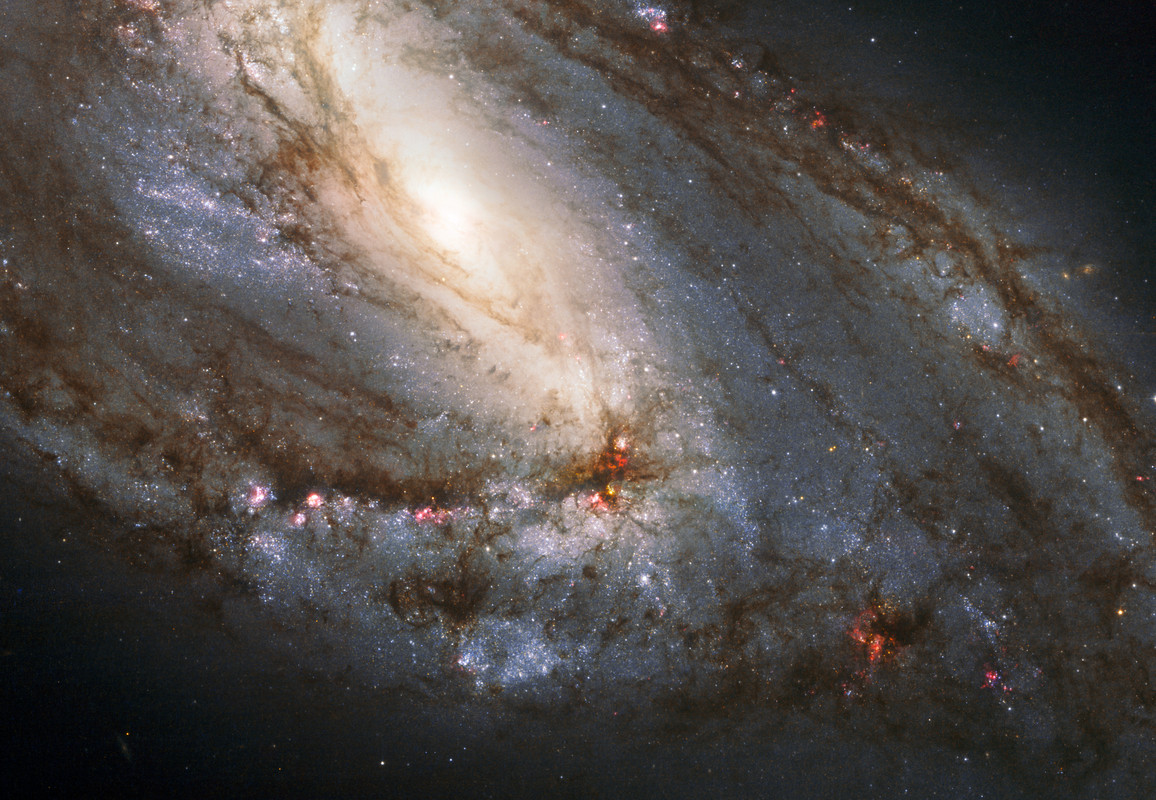
Do dragons fight on the altar of the sky? Although it might appear that way, these dragons are illusions made of thin gas and dust. The emission nebula NGC 6188, home to the glowing clouds, is found about 4,000 light years away near the edge of a large molecular cloud, unseen at visible wavelengths, in the southern constellation Ara (the Altar). Massive, young stars of the embedded Ara OB1 association were formed in that region only a few million years ago, sculpting the dark shapes and powering the nebular glow with stellar winds and intense ultraviolet radiation. The recent star formation itself was likely triggered by winds and supernova explosions from previous generations of massive stars, that swept up and compressed the molecular gas. This impressively detailed image spans over 2 degrees (four full Moons), corresponding to over 150 light years at the estimated distance of NGC 6188.

What is that strange brown ribbon on the sky? When observing the star cluster NGC 4372, observers frequently take note of an unusual dark streak nearby running about three degrees in length. The streak, actually a long molecular cloud, has become known as the Dark Doodad Nebula. (Doodad is slang for a thingy or a whatchamacallit.) Pictured here, the Dark Doodad Nebula sweeps across the center of a rich and colorful starfield. Its dark color comes from a high concentration of interstellar dust that preferentially scatters visible light. The globular star cluster NGC 4372 is visible as the fuzzy white spot on the far left, while the bright blue star gamma Muscae is seen to the cluster's upper right. The Dark Doodad Nebula can be found with strong binoculars toward the southern constellation of the Fly (Musca).

These three bright nebula are often featured on telescopic tours of the constellation Sagittarius and the crowded starfields of the central Milky Way. In fact, 18th century cosmic tourist Charles Messier cataloged two of them; M8, the large nebula above center, and colorful M20 below and left in the frame. The third emission region includes NGC 6559, right of M8 and separated from the larger nebula by a dark dust lane. All three are stellar nurseries about five thousand light-years or so distant. Over a hundred light-years across the expansive M8 is also known as the Lagoon Nebula. M20's popular moniker is the Trifid. Glowing hydrogen gas creates the dominant red color of the emission nebula. But for striking contrast, blue hues in the Trifid are due to dust reflected starlight. The broad interstellar skyscape spans almost 4 degrees or 8 full moons on the sky.
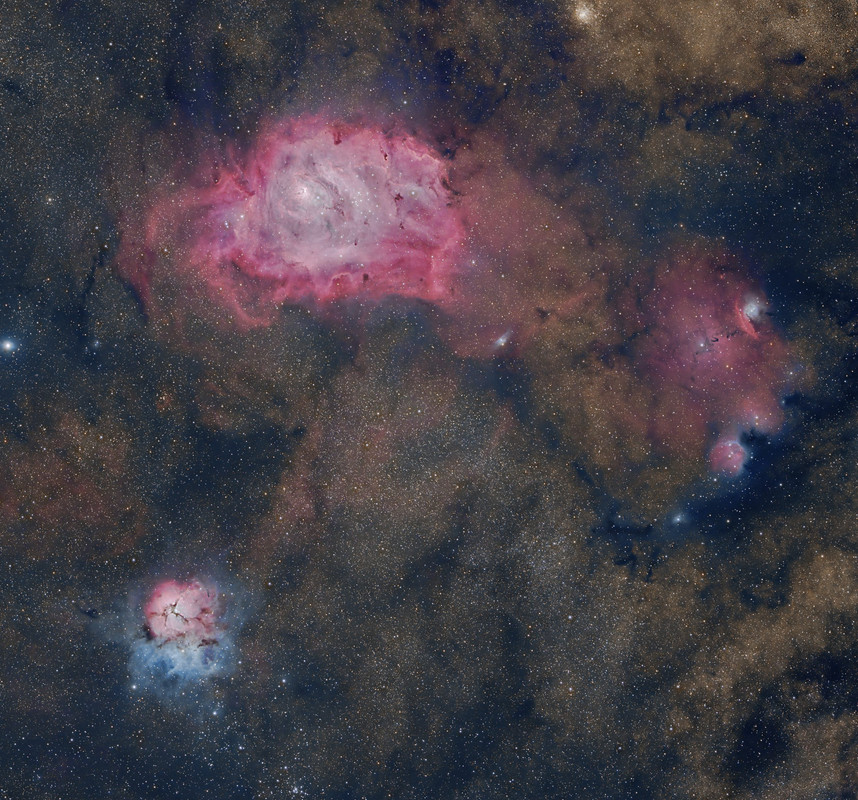
Around 11 000 years ago a massive star ended its life in a powerful explosion, known as a supernova. During explosions like this, shock waves ripple out through the surrounding gas, compressing it into intricate thread-like structures. The energy that’s released during a supernova then heats these threads, causing them to shine brightly. The result is what we can see in this Picture of the Week: the Vela supernova remnant.
This picture is just a small chunk of a much larger image, taken with the OmegaCAM instrument on the VLT Survey Telescope (VST), which is hosted at ESO’s Paranal Observatory. At only 800 light-years from Earth, the Vela supernova remnant is one of the closest examples of these dramatic events. Thanks to its proximity we can study this object in great detail, to help us understand what happens when massive stars reach the end of their life in spectacular fashion.
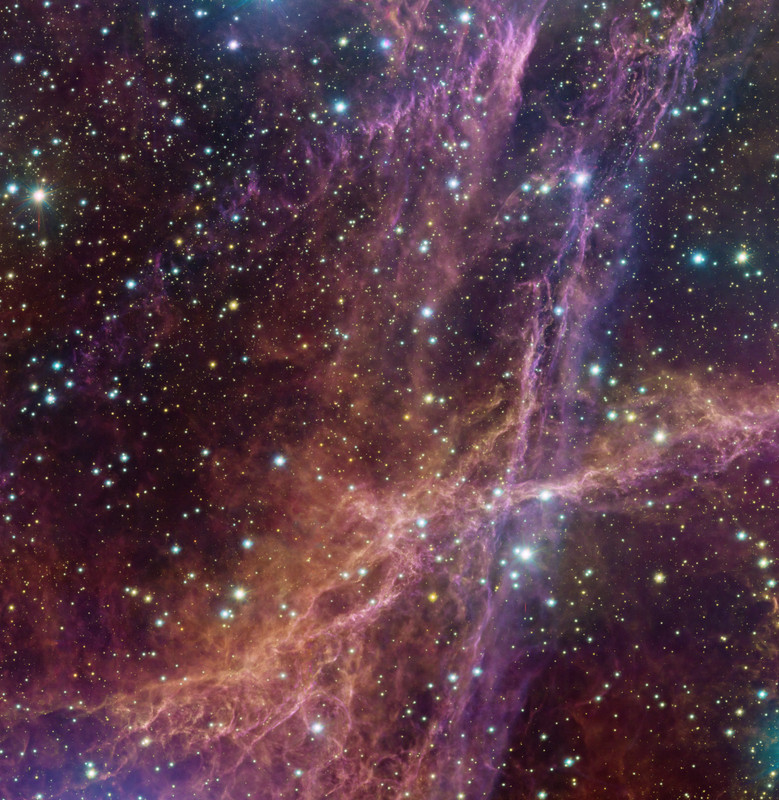
This picture shows the brightly colored Gum 3 nebula as seen with the VLT Survey Telescope (VST), hosted at ESO’s Paranal Observatory in the Chilean Atacama Desert. Attentive viewers may find that part of Gum 3 resembles a Koi fish in this VST image. Equipped with the OmegaCAM instrument, an enormous 268-megapixel camera, the telescope is designed to survey large areas of the southern sky in visible light and take stunning images like this one.
Gum 3 is an interstellar cloud of gas and dust located about 3600 light-years away, between the Monoceros and Canis Major constellations. It is named after Colin Stanley Gum, an Australian astronomer who cataloged 84 nebula in the southern sky.
When the intense ultraviolet radiation from nearby young stars hits hydrogen atoms in the cloud, they emit visible light at very specific colors, which we see as shades of red and pink in the image. At the same time, tiny particles of dust within the cloud reflect starlight, especially blue colors, similar to what makes the sky look blue here on Earth. This play of colors makes nebula like this spectacular to look at.
This image shows not only color, but also the lack of it. Look closely at the area just right of the brightest part of the cloud — right of the pink “Koi-smic fish”. Does anything look odd to you? It’s not that there really are fewer stars in this dark area; instead, there is a big clump of dust that blocks part of the visible light, hiding the stars from VST and us.


Is the Lion Nebula the real ruler of the constellation Cepheus? This powerful feline appearing nebula is powered by two massive stars, each with a mass over 20 times greater than our Sun. Formed from shells of ionized gas that have expanded, the nebula's energetic matter not only glows, but is dense enough to contract gravitationally and form stars. The angular size of the Lion Nebula, officially named Sh2-132, is slightly greater than that of the full moon. The gaseous iconic region resides about 10,000 light years away in a constellation named after the King of Aethopia in Greek mythology.

Why is the sky near Antares and Rho Ophiuchi so colorful, yet dusty? The colors result from a mixture of objects and processes. Fine dust -- illuminated by starlight -- produces blue reflection nebulae. Gaseous clouds whose atoms are excited by ultraviolet starlight produce reddish emission nebulae. Backlit dust clouds block starlight and so appear dark. Antares, a red supergiant and one of the brighter stars in the night sky, lights up the yellow-red clouds on the upper right of the featured image. The Rho Ophiuchi star system lies at the center of the blue reflection nebula on the left, while a different reflection nebula, IC 4605, lies just below and right of the image center. These star clouds are even more colorful than humans can see, emitting light across the electromagnetic spectrum.

Big, beautiful spiral galaxy Messier 66 lies a mere 35 million light-years away. The gorgeous island universe is about 100 thousand light-years across, similar in size to the Milky Way. This Hubble Space Telescope close-up view spans a region about 30,000 light-years wide around the galactic core. It shows the galaxy's disk dramatically inclined to our line-of-sight. Surrounding its bright core, the likely home of a supermassive black hole, obscuring dust lanes and young, blue star clusters sweep along spiral arms dotted with the tell-tale glow of pinkish star forming regions. Messier 66, also known as NGC 3627, is the brightest of the three galaxies in the gravitationally interacting Leo Triplet.

Do dragons fight on the altar of the sky? Although it might appear that way, these dragons are illusions made of thin gas and dust. The emission nebula NGC 6188, home to the glowing clouds, is found about 4,000 light years away near the edge of a large molecular cloud, unseen at visible wavelengths, in the southern constellation Ara (the Altar). Massive, young stars of the embedded Ara OB1 association were formed in that region only a few million years ago, sculpting the dark shapes and powering the nebular glow with stellar winds and intense ultraviolet radiation. The recent star formation itself was likely triggered by winds and supernova explosions from previous generations of massive stars, that swept up and compressed the molecular gas. This impressively detailed image spans over 2 degrees (four full Moons), corresponding to over 150 light years at the estimated distance of NGC 6188.

What is that strange brown ribbon on the sky? When observing the star cluster NGC 4372, observers frequently take note of an unusual dark streak nearby running about three degrees in length. The streak, actually a long molecular cloud, has become known as the Dark Doodad Nebula. (Doodad is slang for a thingy or a whatchamacallit.) Pictured here, the Dark Doodad Nebula sweeps across the center of a rich and colorful starfield. Its dark color comes from a high concentration of interstellar dust that preferentially scatters visible light. The globular star cluster NGC 4372 is visible as the fuzzy white spot on the far left, while the bright blue star gamma Muscae is seen to the cluster's upper right. The Dark Doodad Nebula can be found with strong binoculars toward the southern constellation of the Fly (Musca).

These three bright nebula are often featured on telescopic tours of the constellation Sagittarius and the crowded starfields of the central Milky Way. In fact, 18th century cosmic tourist Charles Messier cataloged two of them; M8, the large nebula above center, and colorful M20 below and left in the frame. The third emission region includes NGC 6559, right of M8 and separated from the larger nebula by a dark dust lane. All three are stellar nurseries about five thousand light-years or so distant. Over a hundred light-years across the expansive M8 is also known as the Lagoon Nebula. M20's popular moniker is the Trifid. Glowing hydrogen gas creates the dominant red color of the emission nebula. But for striking contrast, blue hues in the Trifid are due to dust reflected starlight. The broad interstellar skyscape spans almost 4 degrees or 8 full moons on the sky.

Around 11 000 years ago a massive star ended its life in a powerful explosion, known as a supernova. During explosions like this, shock waves ripple out through the surrounding gas, compressing it into intricate thread-like structures. The energy that’s released during a supernova then heats these threads, causing them to shine brightly. The result is what we can see in this Picture of the Week: the Vela supernova remnant.
This picture is just a small chunk of a much larger image, taken with the OmegaCAM instrument on the VLT Survey Telescope (VST), which is hosted at ESO’s Paranal Observatory. At only 800 light-years from Earth, the Vela supernova remnant is one of the closest examples of these dramatic events. Thanks to its proximity we can study this object in great detail, to help us understand what happens when massive stars reach the end of their life in spectacular fashion.

This picture shows the brightly colored Gum 3 nebula as seen with the VLT Survey Telescope (VST), hosted at ESO’s Paranal Observatory in the Chilean Atacama Desert. Attentive viewers may find that part of Gum 3 resembles a Koi fish in this VST image. Equipped with the OmegaCAM instrument, an enormous 268-megapixel camera, the telescope is designed to survey large areas of the southern sky in visible light and take stunning images like this one.
Gum 3 is an interstellar cloud of gas and dust located about 3600 light-years away, between the Monoceros and Canis Major constellations. It is named after Colin Stanley Gum, an Australian astronomer who cataloged 84 nebula in the southern sky.
When the intense ultraviolet radiation from nearby young stars hits hydrogen atoms in the cloud, they emit visible light at very specific colors, which we see as shades of red and pink in the image. At the same time, tiny particles of dust within the cloud reflect starlight, especially blue colors, similar to what makes the sky look blue here on Earth. This play of colors makes nebula like this spectacular to look at.
This image shows not only color, but also the lack of it. Look closely at the area just right of the brightest part of the cloud — right of the pink “Koi-smic fish”. Does anything look odd to you? It’s not that there really are fewer stars in this dark area; instead, there is a big clump of dust that blocks part of the visible light, hiding the stars from VST and us.

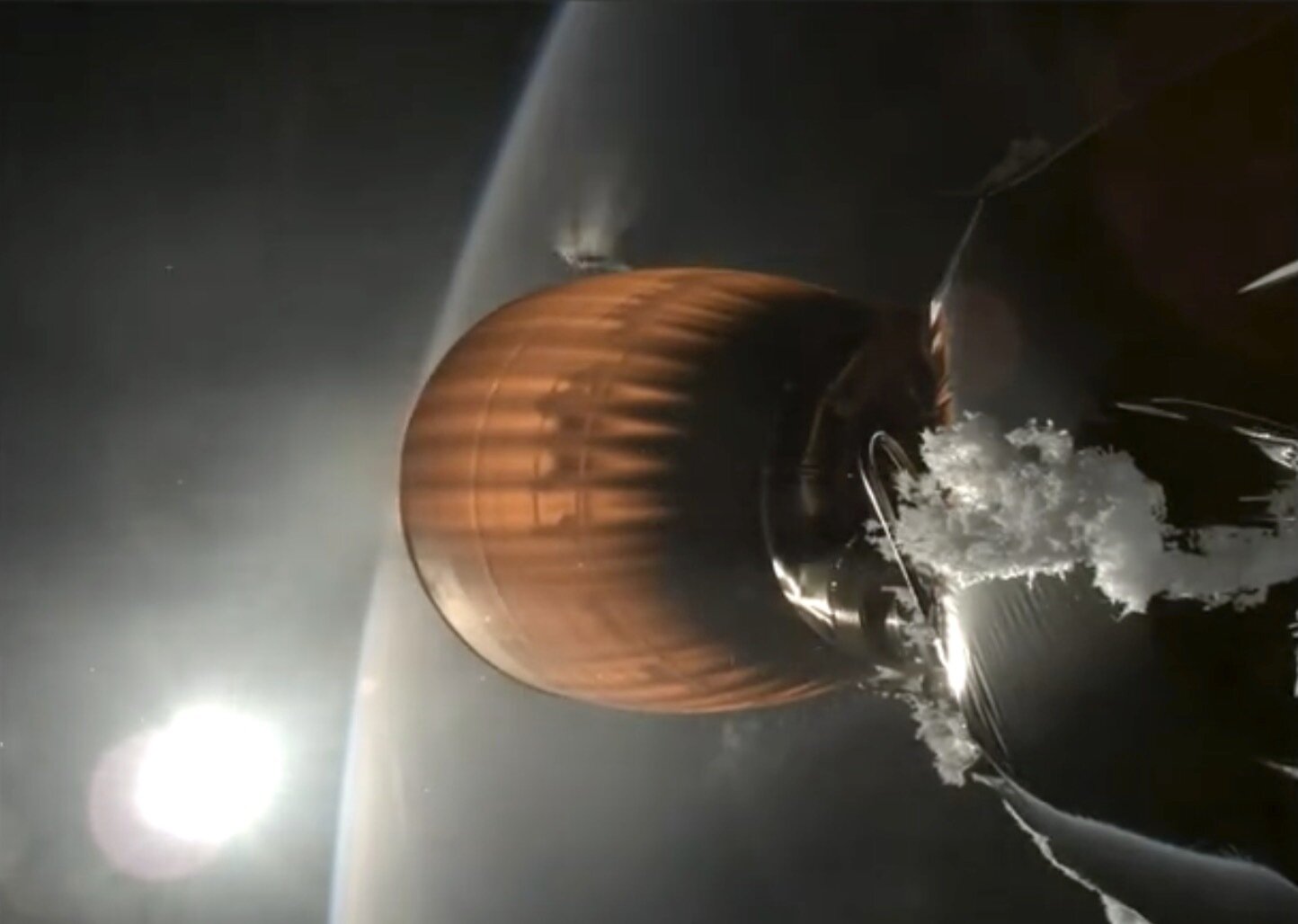
SpaceX rocket accident leaves company's Starlink satellites in wrong orbit
A SpaceX rocket has failed for the first time in nearly a decade, leaving the company's internet satellites in an orbit so low that they're doomed to fall through the atmosphere and burn up.
One of the best meteor showers of year has started
It is the time of summer when we get to look up into the sky each night and try to catch a few shooting stars (meteors) as the Perseid meteor shower started on July 14th. It does not peak until August.This meteor shower is one of the most popular showers of the year, and it will last for around a month and a half. It can produce quite a show when it peaks if conditions are right.
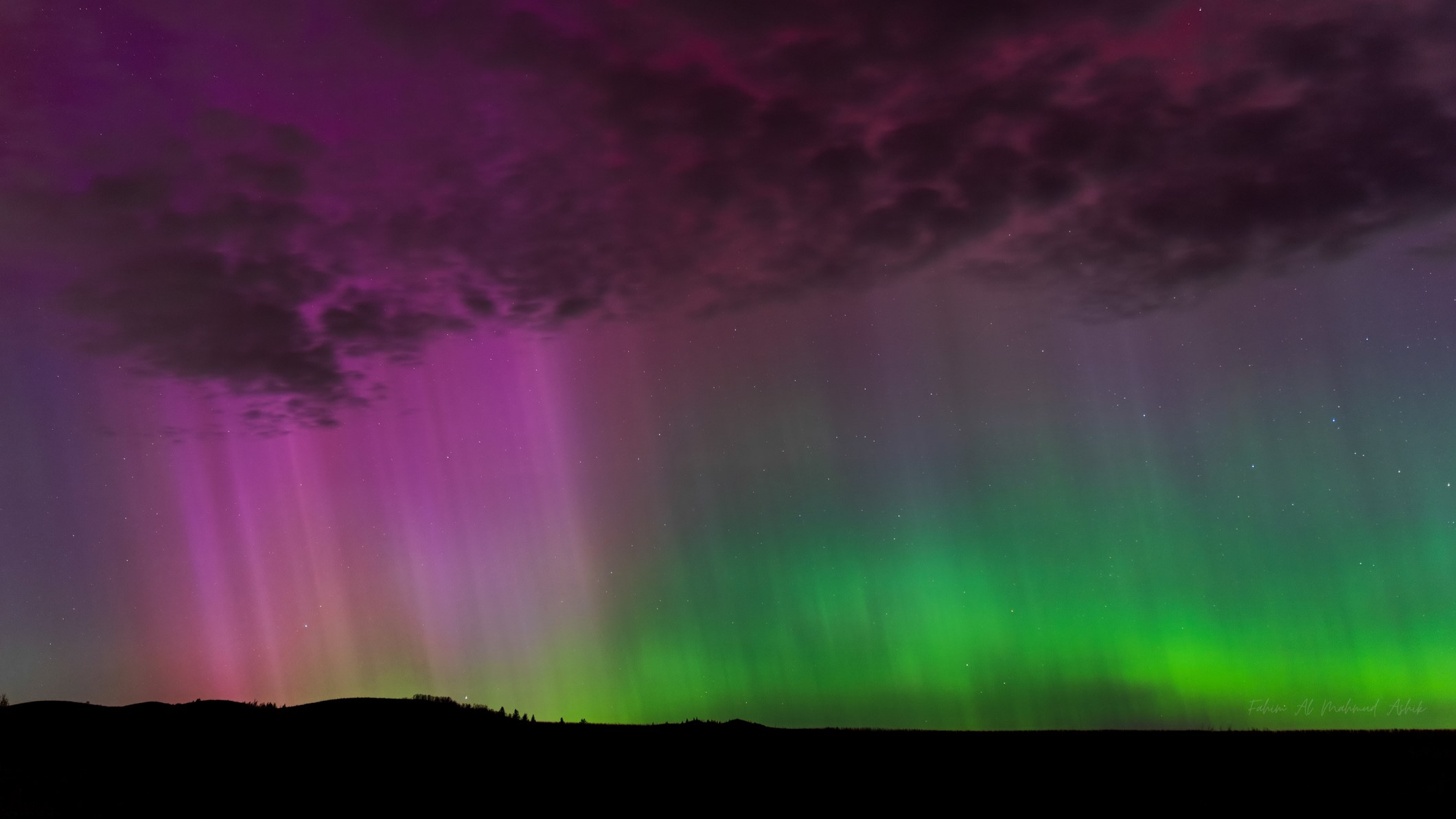
Aurora alert: Possible geomagnetic storm could bring northern lights as far south as New York
Northern lights could be visible over some northern and upper Midwest states.
florduh
Well-Known Member
From NASA's Curiosity rover:

lol imagine spending months in a tin can, getting your balls fried by cosmic radiation. When you finally arrive at your destination... it's just Phoenix with (amazingly) even shittier weather.
I'm a Certified Mars Hater. If we want to make an off-Earth colony, the Moon clears Mars in basically every way

lol imagine spending months in a tin can, getting your balls fried by cosmic radiation. When you finally arrive at your destination... it's just Phoenix with (amazingly) even shittier weather.
I'm a Certified Mars Hater. If we want to make an off-Earth colony, the Moon clears Mars in basically every way

cybrguy
Putin is a War Criminal
"In contrast to the Moon, Mars is rich in carbon, nitrogen, hydrogen and oxygen, all in biologically readily accessible forms such as carbon dioxide gas, nitrogen gas, and water ice and permafrost. Carbon, nitrogen, and hydrogen are only present on the Moon in parts per million quantities, much like gold in seawater."
Mars has about 38% of Earth's gravity, which could reduce health risks associated with long-term space travel. The Moon's gravity is about 16% of Earth's.
Mars has polar ice caps that change with the seasons and evidence of water channels similar to those on Earth. NASA recommends locating a Mars base near accessible water, which can be used for life support, agriculture, and producing rocket propellant.
The main advantage that the moon has is accessibility, but that is just about it. It may be a good place to practice technologies that we might want to apply to Mars when we are ready to colonize it, should that ever occur.
Mars has about 38% of Earth's gravity, which could reduce health risks associated with long-term space travel. The Moon's gravity is about 16% of Earth's.
Mars has polar ice caps that change with the seasons and evidence of water channels similar to those on Earth. NASA recommends locating a Mars base near accessible water, which can be used for life support, agriculture, and producing rocket propellant.
The main advantage that the moon has is accessibility, but that is just about it. It may be a good place to practice technologies that we might want to apply to Mars when we are ready to colonize it, should that ever occur.
florduh
Well-Known Member
The main advantage that the moon has is accessibility, but that is just about it. It may be a good place to practice technologies that we might want to apply to Mars when we are ready to colonize it, should that ever occur.
I'll admit that most of my animosity towards Mars comes from my Musk-hatred. On a long enough time scale, sure. Why not colonize Mars. But in the next 2-3 decades? Doesn't make sense to me.
Plus, the Moon is alien and has a view of the only good planet, Earth. The Mars is cold Arizona.
Mars has about 38% of Earth's gravity, which could reduce health risks associated with long-term space travel. The Moon's gravity is about 16% of Earth's.
Both are bad for humans though. And gravity cuts both ways. Now your space station is at the bottom of a gravity well that takes more power to escape.
This remembers me this (not so bad) comics : What if ? Russians on the moon
This is an alternate history comics where Russians have landed on the moon before the Apollo program. Fast forward a few years, both nations have established living bases on the moon and the Cold War isn't over on earth but the situation is a lot more peaceful on the moon.
This is an alternate history comics where Russians have landed on the moon before the Apollo program. Fast forward a few years, both nations have established living bases on the moon and the Cold War isn't over on earth but the situation is a lot more peaceful on the moon.
The cooperation on the moon comes from a very simple trade. Both teams have created glasshouses on the moon. The astronauts are growing weed and the cosmonauts are growing potatoes to make vodka...
florduh
Well-Known Member
This remembers me this (not so bad) comics : What if ? Russians on the moon
This is an alternate history comics where Russians have landed on the moon before the Apollo program. Fast forward a few years, both nations have established living bases on the moon and the Cold War isn't over on earth but the situation is a lot more peaceful on the moon.
The cooperation on the moon comes from a very simple trade. Both teams have created glasshouses on the moon. The astronauts are growing weed and the cosmonauts are growing potatoes to make vodka...
Very interesting.
I recently started reading The Expanse series of novels. They feature a Solar System wide human civilization using plausibly realistic technology. I remember reading an interview with the authors that kind of bummed me out:
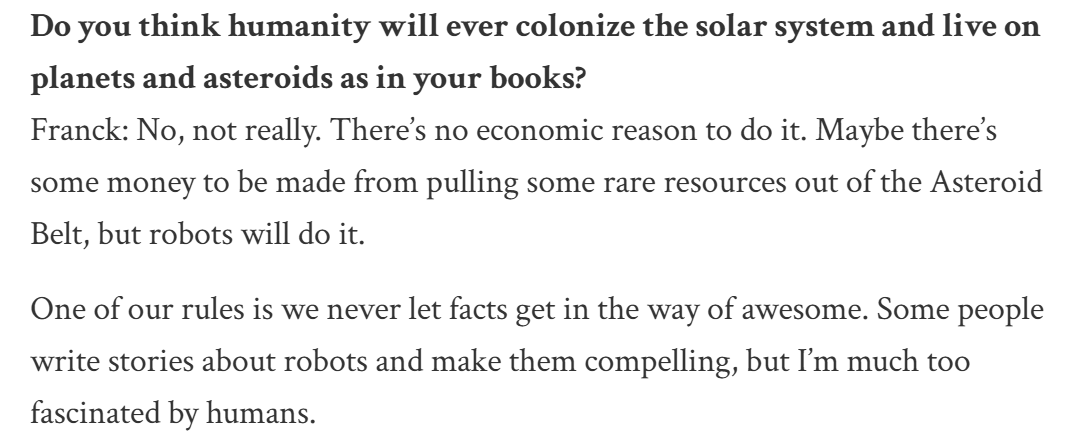
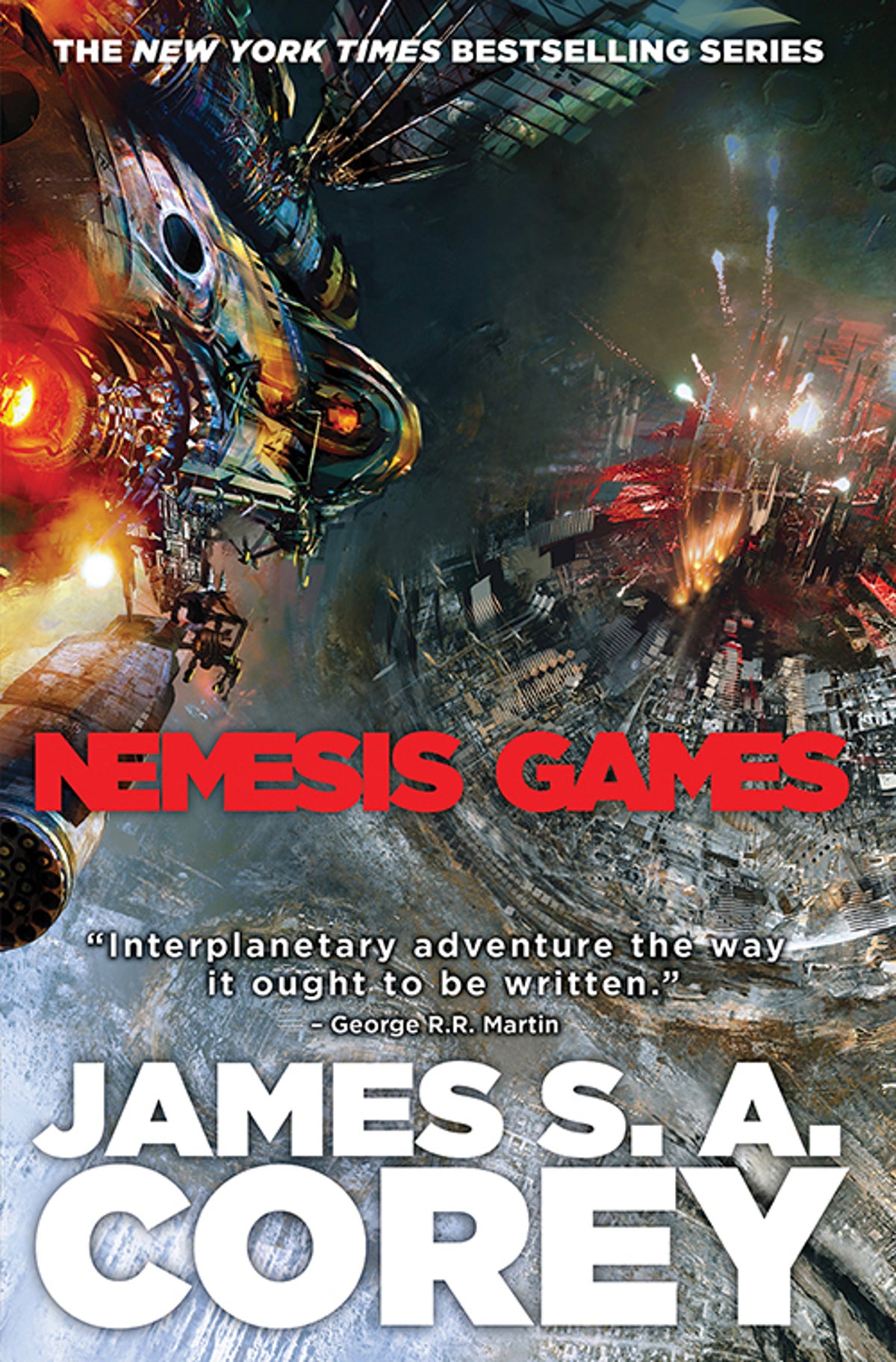
Life in the Solar System: A Q&A with the Authors of The Expanse
Scientific American spoke with Daniel Abraham and Ty Franck about the science behind their books and the upcoming television series based on them
I fear they're right

After all, it was the Communists who started the space race. Say what you want about the Commies, they're motivated by something more than profit alone.
Capitalists would never have had a reason to send humans into space in the first place. There's no profit in it.

CrazyDiamond
HAL is a StarChild
I dunno, maybe Rule of Acquisition #62 applies for Mars?
"The riskier the road, the greater the profit."
Anyways, I'll be back soon, been battling a bad kidney infection with a 3mm stone getting stuck in my ureter, been through 2 surgeries in two weeks with the 3rd and hopefully last one Monday morning. Oh and there was a 1 cm stone as well, both lasered to dust afaik.
"The riskier the road, the greater the profit."
Anyways, I'll be back soon, been battling a bad kidney infection with a 3mm stone getting stuck in my ureter, been through 2 surgeries in two weeks with the 3rd and hopefully last one Monday morning. Oh and there was a 1 cm stone as well, both lasered to dust afaik.
Jill NYC
Portable Hoarder
Hope things get better soon @CrazyDiamond
I have heard that Venus is where we should be focusing our efforts, but I’m too lazy right now to look for the reasons,
so instead I will provide this crazy pic of the moon passing earth:
And this gif:
I have heard that Venus is where we should be focusing our efforts, but I’m too lazy right now to look for the reasons,
so instead I will provide this crazy pic of the moon passing earth:
And this gif:
florduh
Well-Known Member
Hope things get better soon @CrazyDiamond
I have heard that Venus is where we should be focusing our efforts, but I’m too lazy right now to look for the reasons,
so instead I will provide this crazy pic of the moon passing earth:
And this gif:
I notice NASA refused to show the other angle:
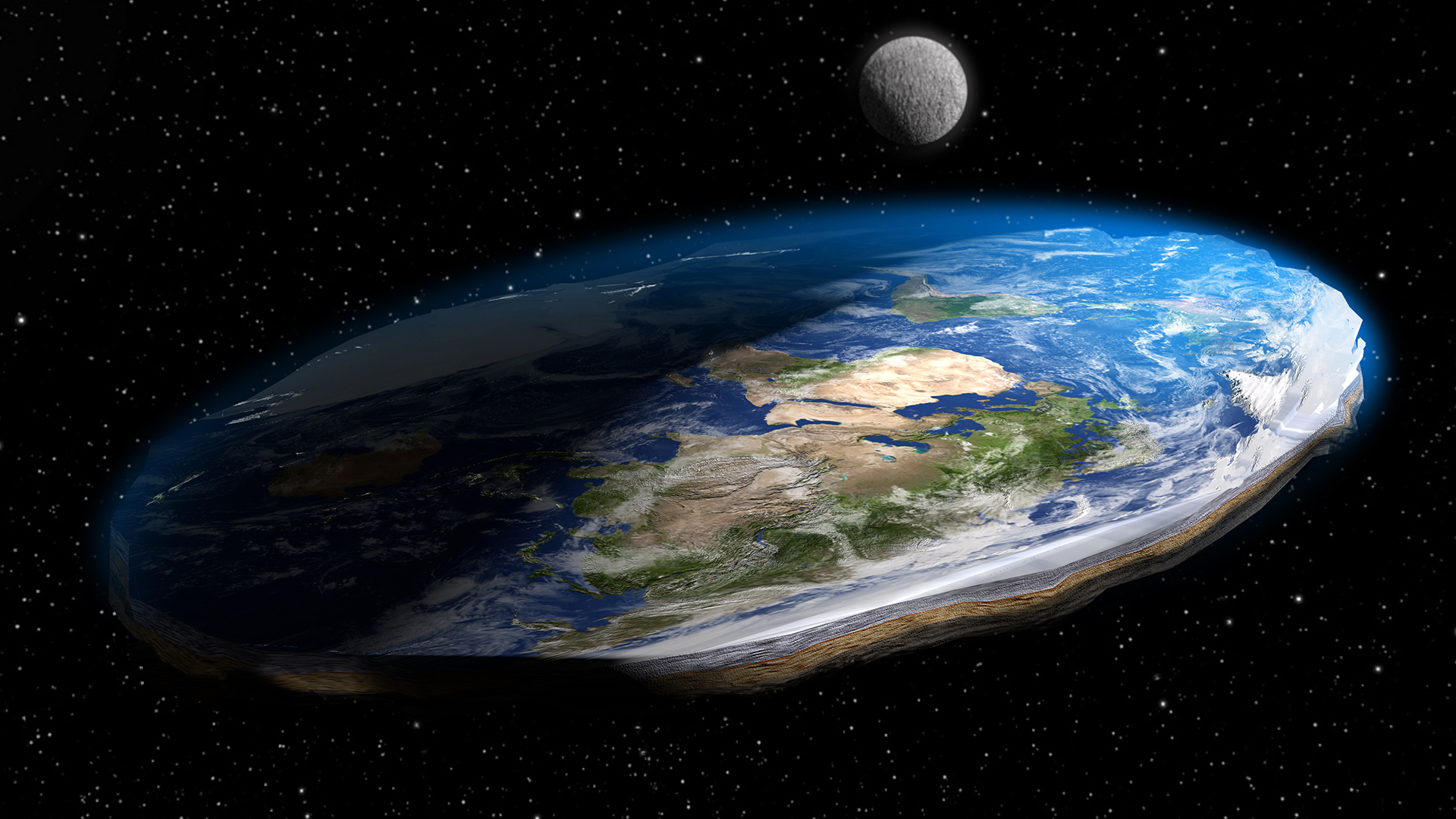
WAKE UP SHEEPLE
Jill NYC
Portable Hoarder
Does that mean the moon is also flat?I notice NASA refused to show the other angle:

WAKE UP SHEEPLE
florduh
Well-Known Member
Does that mean the moon is also flat?
You know, that's a good question. Most of the flat earther pics I could find made it look like the Moon and Sun are spheres. So I guess only the Earth is flat? Not sure about the other planets. But it does seem odd that only the flat part of each planet is facing the Earth

Come to think of it... I remember seeing Saturn through a telescope when I was a kid. Not my pic but this is the right idea:

Like... you can see the damn rings circling the thing
 . I guess that's why it's not called the Flat Saturn Theory.
. I guess that's why it's not called the Flat Saturn Theory.CrazyDiamond
HAL is a StarChild
Thank you all for the well wishes. I am recovering fine and will actually attempt a full work week coming up...but my work understands if I need to not work the full day...they are being very helpful with that side of things. So glad and thankful I have a remote job.

Ocean with life-giving liquid water found on Martian subsurface in stunning discovery
The lander, which has been on the Red Planet since 2018, measured seismic data over four years, examining how quakes shook the ground and determining what materials or substances were beneath the s…
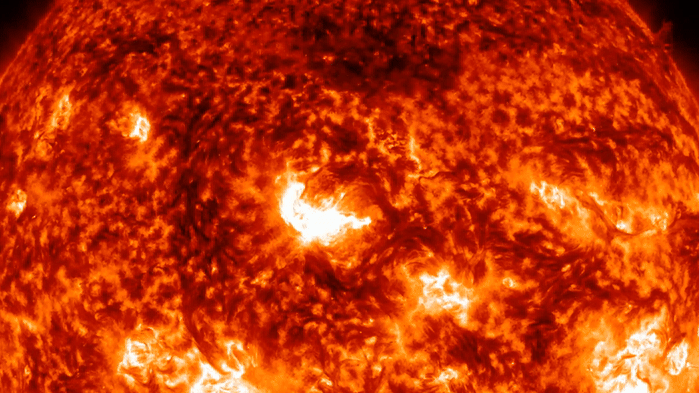
Colossal X-class solar flare erupts from 'rule-breaking' sunspot and Earth is in the firing line (video)
We could expect even more eruptions from this sunspot region in the coming days.


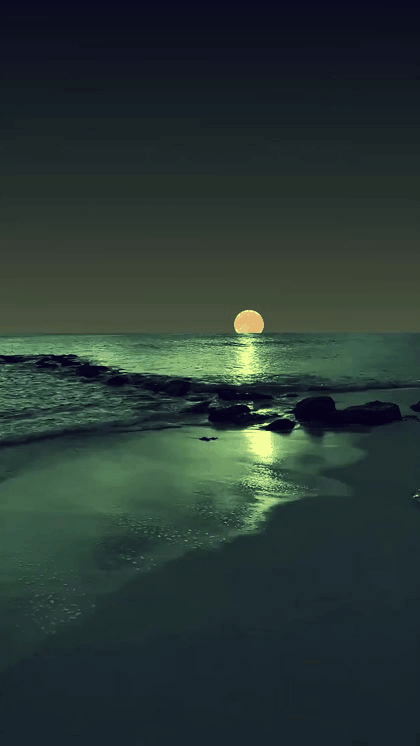


 )
)

